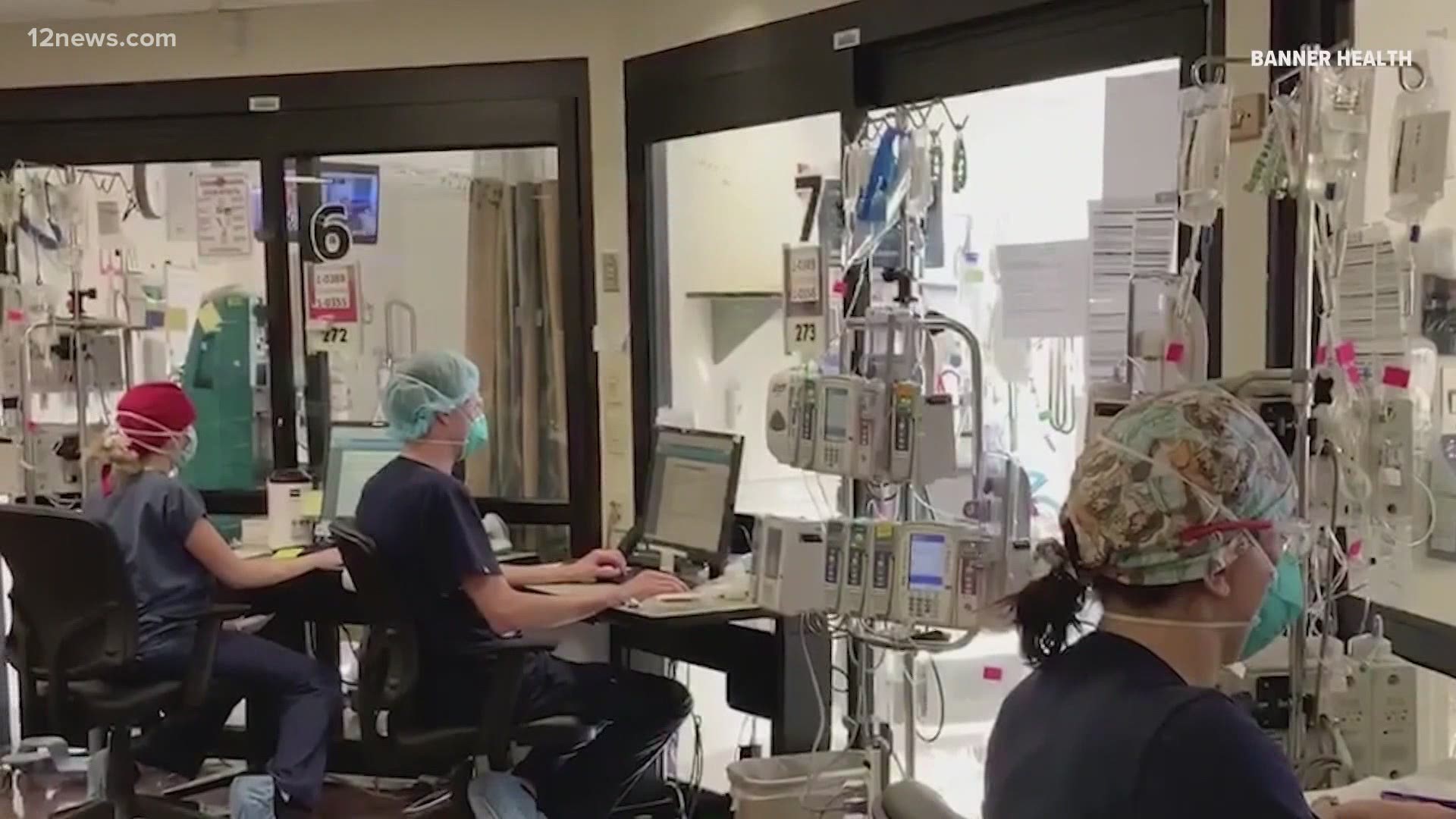ARIZONA, USA —
Valleywise Health Medical Center
“I have one available ICU bed, which means I’m at 98% capacity this morning,” said Dr. Michael White, Chief Medical Officer Valleywise Health.
Arizona's largest public health provider’s ICU beds are nearly at capacity.
The Friday prior to Thanksgiving week, 12 News went inside Valleywise Health Medical Center's (VHMC) ICU COVID-19 ward.
At the time, they were treating 40 patients. That number has almost doubled with many patients requiring ICU care.
Like other hospitals, VHMC is dealing with fallout after the Thanksgiving holiday. They have 12% of their inpatient beds available, but the stress on staff and lack of ICU beds is concerning.
The Arizona Department of Health Services COVID-19 dashboard shows 10% of ICU beds remain available statewide as of Wednesday. It is unclear where those beds are located.
VHMC has a total of 56 ICU beds, however, 10 are without staff due to a lack of providers.
"We make the necessary changes that present to us, we certainly would like to have a buffer. I would like to have increase capacity to make sure we are ready," said White.
Over the last week, VHMC has seen an influx of patients with respiratory illness.
Maricopa County expects to receive 40,000 doses of the Pfizer vaccine to be distributed to two of the five regional points of dispense (POD) after approval from the Food and Drug Administration on Thursday.
Valleywise will partner with Abrazo to staff the southwest POD, but staffing remains a challenge.
Banner Health
Banner Health has added 2,036 seasonal staff – with 406 openings still left to fill for nurses and respiratory therapists. Chief Clinical Officer, Dr. Marjorie Bessel says they are currently treating 50% of the state’s cases.
"Hospitalizations in total in the state of Arizona are now 93% of what we achieved in the peak in the summer," said Dr. Bessel. "Today, 38% of our inpatients are COVID. At the peak in the summer in the state of Arizona, we were at 45%."
As of now, Banner is not pausing elective surgeries. Currently, elective surgeries represent less than 5% of Banner's total hospital capacity. Most elective surgeries that are performed are outpatient or require a short stay.
"Rarely do our elective surgical patients require ICU care," said Bessel. "The elective surgeries that we perform here in all of our Banner hospitals are medically necessary, essential services. They are not cosmetic surgeries. They're things like mastectomies, hip replacements, and gallbladder surgeries."
Bessel stressed that all Banner sites are seeing increases in COVID-19 patients. At times Banner Desert has had 100% occupancy in order to meet the demands of that community.
"We have anticipated staffing challenges even heading into the surge. We are experiencing staffing constraints," said Bessel. At this point, we expect to hit 100% capacity on 12-15 and 125% capacity on 12-18."
Bessel was one of several Arizona hospital leaders who signed a letter to the Arizona Department of Health Services asking for added mitigations to slow the spread of the virus.
"We stated that we need mitigation, and we gave a series of recommendations for that mitigation. We need mitigation both at the governmental policy level, as well as individual level," said Bessel.
What mitigations did hospitals ask the State to consider?
"The items that we asked for-- and I signed that letter, as did other chief medical officers from other health care systems-- included the following: stop indoor dining, no gatherings more than 25 persons, stop group athletic activities including club sports, develop the bidirectional COVID-19 road map with both execution and enforcement-- that's for re-openings and closings-- and put a curfew in place."
Yuma Regional Medical Center
At Yuma Regional Medical Center, more than half of their ventilators are in use, a letter from President and CEO Dr. Robert Trenschel to community members describing a dire reality – bringing on 30 additional staff – but saying quote:
“Seasonal staff have been more difficult to recruit as our Nation’s healthcare system faces the COVID-19 crisis.” and that right now, "Yuma is over two times higher than the national average of cases per 100 thousand."
Yuma Regional Medical Center Dr. Robert Trenschel shared this letter with the community about the new wave of COVID-19 cases. It can be read here.

